Make Faire Plug-in Prius Demo
When Felix Kramer of Cal Cars called to ask me if I was handy with tools, naturally I said yes. As soon as he described the project he had in mind I knew we were about to make automotive history. He wanted to do a public conversion of a stock Prius into a plug-in Prius with a handful of home mechanics over the Earth Day weekend. And he wanted women on the team. I didn't need to be asked twice.
I had met Felix when he came to a meeting of the San Francisco chapter of the Electric Vehicle Association to show us the world's first plug-in Prius. After that I kept running into him dressed in suit and tie at various green transportation events and lectures, handing out literature and being the first one to stand-up during the Q & A to ask the "expert" why we weren't using existing technology such as the plug-in Prius. He was a natural publicist with the added advantage of being tall and professor like. I soon began to see his name in newspaper and magazine articles popping up everywhere touting the plug-in hybrid technology.
In the electric vehicle community, the hybrid car is not really our cup of tea. The technology, we feel, is overcomplicated, expensive and cumbersome in its attempt to be everything to everyone. However we embraced the hybrids because it did, after all, still have an electric motor on board and it was a commercially available production car. When the plug-in concept came along we jumped to promote the missing piece - the plug.
If the public was so resistant to the alien technology of an all-electric car, the hybrid would be the training wheels; the back-up safety net that would ensure nobody would be stranded. Once hooked on the stealth mode of the electric motor and the ease with which it could use the cheaper power from the electric grid, we knew these car owners would be hooked. Gas prices were only going to yo-yo to ever higher numbers as oil supplies diminished, not to mention the increasing threat of global warming and the long term tragedy of going to war over oil.
To attempt a two-day conversion in a public venue was ballsy to say the least. We had never worked together, all of us; we did not even meet everyone until the morning of the event at a breakfast cafe. I sat across from the owner of the Prius going under the knife. He was young with long hair and a goatee; an EV enthusiast who had bought his '05 Prius nine months ago after he had seen the plug-in option could be done. He was looking a little nervous, but would soon prove an eager mechanic, overseeing every step of the process.
Sitting next to him was Sherry Boschert, who's book, Plug-in Hybrids: The Cars that will Recharge America would be coming out near the end of the year. We also had, on the team, a married couple from Santa Cruz who sold kits to people wanting to convert their cars to electric, the lead engineer from the original conversion, the president of the Seattle EV club who had done his own conversion project, a Silicon Valley engineer, a fellow activist who put together the Plug-in America site, a jeweler who sold solar power systems and would lead our project and a Toyota mechanic who had been helping the team by scouting out the odd part from Toyota and copying, for them, nearly the entire Prius shop manual.
"This may not work", Felix cautioned us. "I don't want you to give the impression that this is a sure thing. It may turn out that it isn't even worth it." Yes, the important thing was that we were doing it at all.
Arriving at the San Mateo Fairgrounds, we met the camera crew. The project would be taped from start to finish by two professionals. As activists, we had learned from the history of the electric car and its demise that the media could not be relied upon to inform the public of innovations that might upset the combustion engine status quo.
We had just seen the new documentary "Who Killed The Electric Car" which by complete coincidence was showing the night before, at the San Francisco Film Festival. This tale, of GMs much loved EV1 being sent to the crusher despite the popularity of the car and the horrified cries of those who wanted to keep it, was a neat summary of how corporate power, in collusion with government and oil interests, squelched any innovation threatening to their hegemony. The plucky, democratic, American can-do spirit, that we are counting on to solve our planetary problems, was clearly being trampled. Audiences come away outraged and wanting to do something. The film, distributed by Sony Classics, will open on June 28th in a handful of major cities. With a bit of luck it will build on the buzz it is already getting.
Once the cameras were rolling, Tom, our team leader went into hyper drive pulling out the storage compartment above the spare tire, the tire itself and the surrounding interior housing. He gave out assignments to cut plexi-glass, hammer copper tubing, splice wires and assemble components. With twelve on the crew, we had plenty of hands; enough to assure that there would always be someone to answer questions from the public.
And who were these people I wanted to know? After cutting some plexi-glass pieces, I went to investigate. This was the inaugural Maker Faire, sponsored by Make Magazine, a new quarterly. Advertised as a celebration of do-it-yourself ingenuity, it was part science fair, part craft fair. At first glance the fair appeared to be filled with pyrotechnic displays, ax wielding robot tanks and homely wooden bicycles that defied logic or the rider to ride them. It seemed to be the anti-thesis to my green festival, solution-oriented sensibilities.
Why were these people spending their creative energy making these inane toys? Where were real world solutions to our dire problems? I regained my sense of humor upon seeing the rubber chicken catapult and the laxative propelled dildo drag racer; the faire began to speak to my inner geek. Heck wasn't it great that people, especially kids, were absorbed in making something instead of shopping? Whether it was a propeller driven boat made from plastic bottles and aluminum cans or a sibling intruder detector, the Maker Faire was bringing alive the human desire to create and solve problems.
The magazine itself was largely ad free with a question authority flavor about it. It embodied the Maker Bill of Rights, a document demanding that all the annoying design elements of consumer products that would quickly deem the item trash should be abolished. Tamper proof enclosures, for instance, or special tools and non-replaceable batteries that made the product difficult or impossible for the owner to repair it.
"If you can't open it you don't own it" was the slogan on the t-shirts.
There were no tamper proof enclosures on the Prius, but the warranty violation was enough to deter most owners from hacking into it as we were doing. Not this crowd though. Only a few asked if we would void the warranty. For the computer and electronics maybe, but not for the rest of it, we told them. What the owner would sacrifice was access to the spare tire as the new batteries would sit on top of the spare tire wheel well, but the cargo space would still be the same.
What people did ask was "why wasn't Toyota doing this?" Our makeshift set-up was so obviously inferior to the resources and brains of a modern automotive factory. And with no access code, we were having to "spoof" the computer, fool it into accepting the new battery pack without shutting off the electric mode and turning on the gas engine. When I told people that Toyota didn't think the public would understand the concept or accept a plug-in option, they rolled their eyes. This was a crowd eager to jump on every new innovation.
The auto industry has many excuses, but we believe that what they fear most is that the electric motor technology would suddenly switch the entire industry over to this superior technology just as digital cameras had rendered film cameras obsolete. The combustion engine, with all its after market servicing needs, would be gone and oil profits with it. Toyota claims that battery technology is not here yet even for a plug-in hybrid, but we know that they made the RAV4 EV with a range of 100 miles using the nickel metal hydride battery (NiMh).
The battery pack being installed into our project were small lead acid batteries used in motorcycles and electric bicycles. They were cheap and available, but would only have a range of 20 miles and would add 300lbs in weight. (I spent a good part of the weekend hammering lengths of copper tubing flat and shaping them into connectors to bolt to the battery terminals, thus forming an electrical path between them.)
The lighter and better performing NiMh batteries are only sold in large lots suitable for mass production. Since an oil interest has a controlling stake in the company that makes them, we suspect that this is an effort to keep home mechanics from building viable electric vehicles. The new hope was in lithium ion batteries. Though expensive, these batteries, in an electric car, would boost performance beyond the combustion engine altogether. The car companies had no excuse.
What we were trying to do was show the public that the technology was here and create a demand for it. Many visitors to the booth thought we were in the business of installing the option ourselves and were annoyed when I told them this was just a demonstration and the only U.S. company able to give them the plug-in option would take 6 months to install it. For about $3,000 in parts they could do it themselves, but what we wanted them to do was go to their dealer and ask for the plug-in option, thus letting Toyota know that we had let the cat out of the bag and consumers were demanding it. Such are the visions of the grass roots activist.
On Sunday CNN showed up. Felix had been talking to the press tirelessly all day and now we couldn't find him. An urgent call was made to his cell phone and I answered the reporter's questions until he showed up. The press had been covering the fair all weekend and the Seattle EV president had already been on Channel 5, Saturday night, delivering our message.
Sunday morning we started seeing reporters and cameraman early in the day. One reporter said that he particularly wanted to find us because we were the only exhibit doing something that was actually useful. Bing, bing, bing. Jackpot. Yes this was what we had wanted to achieve. Never mind that the project would not be finished by the end of the fair. (The crew would stay late into the night, then drive the car to another location where they would continue to work on it all day Monday to ensure the car was operating with the new battery).
To wrap up our demo we did a mock installation of the battery pack for our camera crew, followed by a group photo and cheer. We were happy to act out this triumph for now it was documented and would serve to show that we had tried. We had defied the powers that be and shown that ordinary citizens could bring forth real solutions to real world problems.
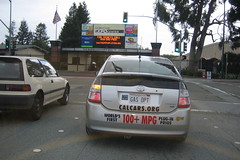
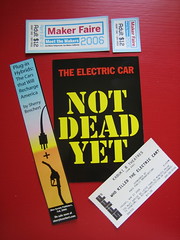
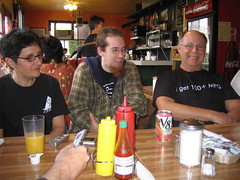
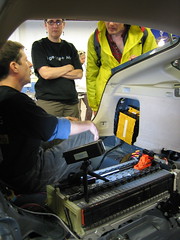
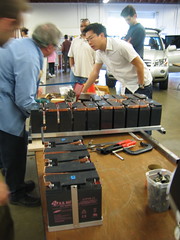
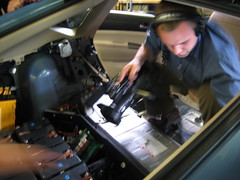




12 Comments:
WAHOOOO!!!!
How did you find time to notice anything that was going on around you? What a herculean task, and what a marvelous result.
YAY!!!
Thanks Robert and I agree with you dub_scratch about the need to reduce car usage altogether, but don't entirely agree with your figures regarding the displaced emissions to electricity plants and the miniscule improvement over efficiency compared to ICE cars. We definately need to work on cleaning up our energy grid, first, because it will help clean up our vehicles.
I and several of the EVer's, who participated in this demo, power our cars with power generated from solar panels on our houses. We realize this is an expensive (call it eco-elitist if you like) option for the majority of cardrivers, so we also actively lobby our government for incentives and rebates for people to install solar panels that would provide a more cost effective way. We also count the cost of gasoline saved into the cost of our solar installation.
Most of us have bicycles, too, and I would happily advocate cycling to the general public, but I have found very few willing to risk riding alongside an SUV in even the quietest of suburban neighborhoods. If you have been able to convert a friend to cycling for even some of their errands, please share your story. I cannot seem to get around their fear factor, short of personal escort.
I look forward to ending the car culture as you do, but in order to do so in an America that demands freedom of choice and a high level of personal mobility, the suggestion we are making, with this demo, is to give more options that are less environmentally impactful.
True, we are appealing to the usual self-serving incentives (and a little bit of eco-status) of giving people more for their energy buck without compromising their choice to drive whenever and where ever they want.
Would it be better to offer no economic incentive and no solutions in the hopes that people will just come to their senses and realize that to drive one more mile is planetary suicide or that they become so angry at the oil company profits that they decide, en masse, to dump their cars instead of lobbying our corporate owned government to keep gas prices low so they don't have to give up anything? Highly unlikely. Even the most enlightened, progressive people still make compromises (ie: drive to work) in order to earn a living.
Given the dire situation we are in with both global warming and peak oil, it would be best if we used our remaining resources to provide everyone with a bicycle and create government policy that limits the use of cars, but the only governments I know of that could carry this off is China which is going the other way. One that has done it is Cuba (also considered a fascist regime).
We can also lobby our government to provide public transit and we do, but by the time it gets around to building the high speed train system that has been on the drawing board for the last 30 years or the BART extension that has been voted for repeatedly, we may not even have enough steel to complete the task.
It is all very well to argue that the technological fix is a shoddy interim solution that does not deserve the status of the term sustainable (and I agree with you wholeheartedly), but we are also committed to democracy in our social organization and while I would welcome an eco-driven dictatorship, I would definately not like being told what to do and probably would not like the centralized solutions that would be made in such an oversized country.
If you can tell me how we are to get this population, in this oil concessions created infrastructure, to give up their high level of personal mobility, their air conditioned high energy buildings and everyday-low-prices driven consumerism, please, please let me know and I'll get right on it.
I also attended the Maker Faire. It was nice to see people who were not 100% bought into American celebrity consumer culture. I figure if you go to a lot of effort to make something yourself you are not as likely to throw it away because a slight cosmetic upgrade is available. I also found it strangely comforting that a bike frame could be made from wood.
Although Segway polo did seem rather elitist and wasteful.
I'm sorry I missed the Prius conversion demo. I didn't really get to see everything I wanted to.
I do ride my bike to do errands. I was starting to commute 9 miles to work on a regular basis then it rained for 6 weeks and then I got laid off.
One of my prime considerations for a new job is for it to be within biking distance.
Vicky t, I commend you for riding 9 miles to work and for looking for a job within biking distance. I can manage 6 miles.
Timmy! thank-you for backing me up. Yes the "well to wheel" calculation varies a lot depending on situation. Also the impact of EVs on the grid in terms of pushing up demand, depends greatly on time of use. Austin, Texas which has invested in wind power are generating electricity at night that is not being used, so they are particularly interested in promoting plug-in hybrids and EVs that would be plugged in at night and they are doing so.
www.chron.com/disp/story.mpl/conws/3853125.html
As for you dub_scratch, your refusal to discuss options and analysis other than your own, in order to push your opinion of what evils we EVers are advocating is obvious to everyone. Your frustration at the status quo and your near religious, fundamentalist style ultimatum that we go carefree or die sounds suspiciously like the cries of a wounded man who knows that the battle is lost. You have my sympathies.
See http://www.sherryboschert.com/FAQ.html for the most complete overview to date of all the studies on well-to-wheels emissions for electric vehicles or plug-in hybrids vs. hybrids or conventional cars with internal combustion engines.
dub_scratch, your insistence that plug-in cars will increase CO2 emissions appears to be more emotion than fact. Can you point to any data or studies that back you up? Because there are lots that contradict you.
dub_scratch said: See for your self here: USEnFlow02-quads.gif
You may have to follow some of the links here as no single .gif flow chart is going to tell you the whole story.
A good portion of that lost electricity generation may be due to unused off-peak power, which could be fueling millions of BEV/PHEVs without adding any new generation. Power plants can also utilise co-generation techniques to make use of what would otherwise be waste heat.
I'm not advocating more clean coal powerplants but would rather we rapidly invest in wind resources which have 5 times the potential of total global consumption, or 40 times global electricity consumption, and these figures do not including off-shore and evolving wind generation technologies. Furthermore BEV/PHEVs are a perfect complamentary technology to the intermitent nature of wind energy.
On the oil side of your graph I see 26.5 in and 5.3 out for 20%. But does that represent the oil in to gassoline/diesel out which must then be multiplied by the 30% effeciency of an ICE making it 6%? What if you also considered the effeciency and time required to create the oil to begin with? Sure makes near term solar (wind, hydro) look better than FF. Refineries are also one of the largest users of grid electricity, so using less gas results in using less electricity, which could instead fuel BEV/PHEVs directly.
Anyway, good luck getting folks to give up their cars. The next best thing will be giving them electric cars that will get cleaner as they age and who's owners will have the option to produce their own fuel with home based solar or regional wind.
Take care -Ryan
I have already provided data relating to the thermodynamic efficiency of electricity generation, which is 31%
Oh, I forgot something, electricity generation is not soely limited to thermodynamic effecienty. Electricity can be supplied from resources which are not based on thermodynamic systems (aside from the Earth in as much as it as a whole is a thermodynamic system)
Nothin' but Love -Ryan
This study http://www.memagazine.org/mepower03/gauging/gauging.html
confirms what dub scratch said. Interestingly, however, the most efficient options are hybrid diesel and gasoline engines. They blow away both the conventional ICEs and batteries.
If this study is correct, it would be best to focus on hybrid technology and forget the EV only and perhaps the PHEV option.
Although, I must say, EV and PHEVs might make sense if recharged using the base electric load. I've seen estimates that we could replace 10% of our fleet using the base load. Well to tank efficiency in that instance would be largely irrelevant as we would be using electricity that is wasted anyway.
Another point is that we may be comparing apples to oranges. The small percentage difference in efficiency may not account for a situation where you are comparing a sparrow to a camaro.
Another issue is that PHEVs might encourage people to live closer to work so that all the motive power could come from the grid. Say what you will about efficiency but the running costs of electric are a lot less than gasoline.
FWIW, I would like to live in a largely car free society, with the minimum requirement that cars be banned from all major cities. PHEVs, EVs, hybrids should only be used when all other options have been exhausted.
Regardless, however, let's work to have the most efficient vehicles possible. Even with car free cities, ubiquitous and good public transit, we will need the occassional car ride to get to certain places.
Since the sticking point of our discussion seems to rest on efficiency, I consulted with a friend who is a physicist. Here's what he says.
"Yes, I do think that the efficiency of electrical generation, (power in at the [coal-powered] electricity generation plant)/(power out over the electrical grid) is near 30%.
Even so, EVs are still a lot more efficient than combustion: given the numbers quoted by dub_scratch, an EV will go 23/20 = 1.15 as far on a given energy input. 15% more efficient, not 3%. Watch those denominators!
Gasoline engines use gasoline -- a premium fuel, a small part of the barrel, difficult to refine. The American Petroleum Institute tells how hard it is to get gasoline from a barrel of oil: www.factsonfuel.org/gasoline/index.html and Adventures in Energy! www.adventuresinenergy.com/interactive/all_5000.html. Also api-ec.api.org/about/index.cfm. I couldn't easily find a number on the "efficiency" of this process, but I assure you that energy is used in the refining process and the energy in the products from a refinery is less than the energy of the oil & gas going in. dub_scratch seems not to have taken this efficiency into account. Also, gasoline is a premium part of the barrel -- worth more in dollars per amount of energy than many of the other products.
Electrical power plants use coal, bottom (cheaper) oil, natural gas -- and solar, wind, biomass, hydropower, geothermal -- even nuclear energy. Pollution control is easier in an industrial electrical-power plant than on a million cars, maybe not maintained all so well. If you have solar power on your roof, and charge up your EV from it -- no carbon emissions at all!! Using EVs means we can solve the carbon and pollution problems at the input to the grid -- not on each and every car. (And this too is a problem worth solving, whether or not we have EVs.)"
Tom's point about using the base load (electricity that is not going to be used anyway) is also one of our selling points for the EV.
I am also looking forward to reduced car use and was very happy to read in the Chronicle today that a "pay as you drive fee" is being considered for downtown San Francisco.
Well then let's hear it for the tiny, tiny, tiny minority. You on your bicycle and me in my sun powered, yellow Sparrow.
Love and kisses,
Amanda
While we were battling furiously, here, over the viability of EVs, I wrote a letter in response to the Chronicle's article on the "pay as you drive fee" to relieve congestion in downtown. I saw the opportunity to advocate cycling as a hidden benefit of increased driving fees. It was published in the Sunday Insight section. Photo here. Many more people saw it than come to this lil' ol' blog.
Let it be known that I wrote it, not because of Dub's vociferous car free advocacy. His stubbornness only taught me how to strengthen my argument for EVs. I wrote it because I am an equal opportunity promoter of alternatives of all kinds and I believe in encouraging people to explore solutions. Naysayers are energy stops; nobody wants to be told they can't do something. It was the naysayer quoted in the above article that prompted me to write my letter challenging the premise that Americans won't give up their cars.
I haven't had the opportunity to read every line here, so maybe I amissing something, but... where is the video and how about th eprocess in detail? I would really like to do this, with lighter lith-ion batteries, but see no link to those details...???
radmacdaddy@mac.com
Post a Comment
<< Home